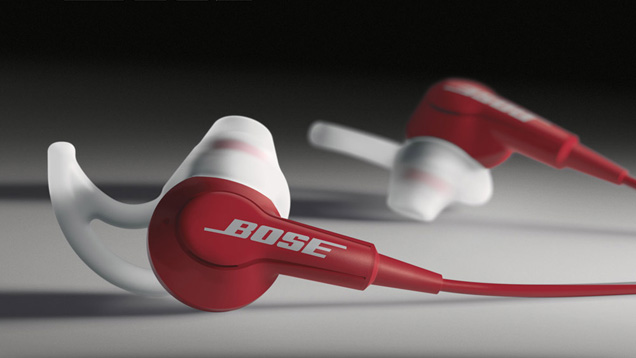I’m a headphone junkie. I have headphones in all shapes and sizes, but there’s one small problem: I don’t like things that dig deep into my ears, which most traditional in-ear headphones do. So I’ve embarked on a search for more comfortable options… and it’s been more complicated than I expected.
Some people have no problem with in-ear headphones, but there seems to be a group of us that absolutely hate them. It must be the size or shape of our ears, because I have numerous problems with in-ear headphones that otherwise come well reviewed — they hurt, they don’t stay in my ears, and none of the sizes seem to fit me. So what’s a headphone junkie to do?
I’ve spent the past few months trying out different tricks, products and DIY solutions for more comfortable in-ear headphones. After a lot of trial and error, I found a few things that worked — some better than others — and gave me the beautiful mix of comfort and portability I’ve been looking for. Which method you use depends on the headphone, how much you’re willing to spend, and — most of all — your preferences (both when it comes to sound and comfort).
Option 1: Foam Tips
If you find that traditional silicone tips just aren’t giving you a very good seal, foam tips may be the next best option. Comply Foam is a popular brand with many different styles, which you can read about in our review. The “Comfort” and “Active” style are the most comfortable, and the Comfort style is the least intrusive when it comes to your ear canal.
I found that, while these were much more comfortable than silicone tips, they had their annoyances. They still weren’t as comfortable as I’d have liked (after all, you’re still pushing something into your ear), and they take a little longer to insert since you have to “prep/” the tip. They give a great seal, although it will alter the sound of your headphones — most notably by boosting the bass.
If you don’t like Comply tips (or don’t want to spend the money), you can try the cheaper Bluecell foam tips, or DIY it with a pair of foam earplugs.
Option 2: Custom-Moulded Tips
Truly custom-moulded tips can cost hundreds of dollars from audiologists, but there are some cheaper do-it-yourself options that work well enough. I personally love Decibullz’ custom-moulded tips. They fit on a lot of in-ear phones, you mould them to your ears, and then they fit you perfectly — without digging into your ear canal. (Make sure you buy the custom tips and use them with your favourite headphones, rather than buying Decibullz’ mediocre headphones).
These have downsides as well though. They won’t fit as many in-ears as foam tips will. They will also alter the sound of your headphones, in the opposite way foam tips will; you’ll lose a lot of bass since you aren’t getting that perfect “seal”. I fixed this by a) using a more traditionally-shaped earbud, and b) lightly pressing on the moulds — on the upper, lower and middle part of my ear — as they harden. I did this for about 10 minutes — twice as long as the instructions called for — and with my mouth open, biting down on a small plastic tub. Since Decibullz are plastic, they actually shrink a bit as they cool, so you want to make sure they’re moulding the contours of your ear as closely as possible, and following normal instructions, they don’t do that very well.
If you don’t like the Decibullz, you can try this similarly-priced DIY method using Radian earplugs. I found that, while they fit my ears better (since they expand as they harden), the sound was absolutely awful. Some prefer it, though (they’d make good in-ear monitors for live performances, for example).
Option 3: Specialised Comfort Earbuds

If none of the above options work for you, it may be time to buy some new headphones focused on comfort. Unfortunately, that often means going the earbud route as opposed to in-ear headphones, which means they won’t always sound as good. There are a lot of different ones out there, from the more exercise-focused Yurbuds and Sennheiser PMX line to pseudo-in-ear headphones like Bose’s SoundTrue line. I’d even argue that Apple’s EarPods (gasp) are pretty comfortable and sound decent — though they are one-size-fits-all, so it really depends on the size of your ears. I was shocked to find that I actually liked them.
In the end, I’ve landed on the Decibullz (paired with these Panasonics) for my portable headphone needs. They aren’t perfect, and they’re a pain to mould properly, but after re-moulding them for what feels like 100,000 times, they’re the best option I’ve found. I have a headphone that sits just inside my ear without digging into my ear canal, and without losing too much bass. If you’re part of the in-ear-hating club, experiment with the above to see what works for you.

Comments
10 responses to “My Never-Ending Search For Comfortable In-Ear Headphones”
These really don’t work for me. They scrape up my ears and leave them raw and bleeding and then crusty. Yuck. I’m an over-the-ears person only!
Plus they do damage to the fine workings of the auditory canal.
There’s probably a class action suit brewing on all these in-ear plugs.
@barb
if you are having issues like that, you should consult a doctor or ENT specialist,
To make silicon ear buds fit better, pull your ear up and back as you insert the earphone. It widens the ear canal slightly and you will get a much closer fit. Also works for foam hearing protection.
The best fitting ones I have are the worst sounding. $10 job from jb. My LG ones sounded pretty damned good but I don’t think they were made for human ears. Very hard to get to fit with out falling out or vacuum sealing into your head. Samsung ones I have now and in the past. Eh they do the job for Pandora at work.
Why? Because the insides of my ears are so much smaller than others? Some people have insides smaller than others — ask any woman (she says, carefully avoiding context).
I’d say yes. From what you say, your ears probably aren’t the right size or shape for ear buds (or the other way around). There is a slight possibility that you are pushing them in too far and scratching your ear canals. It Checking with a health professional will give you a much better answer than an idiot commenter like me, but it may be that the answer is just be that standard ear buds and you will not be happy together.
A cheapish custom option is to get your ear molds done at an audiologist (around $60) and then order a pair of Custom Art Music One in-ear monitors (at least $250). Most alternatives cost a lot more from brands like Noble Audio and JH Audio.
That’s the route I’m considering, just gotta do some more research. One benefit from choosing custom IEM’s is that you can listen to them comfortably while having your ear pressed on a pillow.
I was just like this, until I came across Medis from Urbanears.
Six months using them and I’m very happy.
They are comfy and never fall out. They don’t sit in the ear canal, but are wedged comfortably in the shell of of your ear.
I have fallen in love with yurbuds. Very comfortable and won’t fall out.
I find Shure SE215s to be pretty comfortable, I can wear mine for several hours at a time and not feel any worse off, better yet they seal pretty well and stop a lot of external noise which is perfect when doing lawn work with wipper snippet pumping out around 105db!
PS sorry for cut and paste typos